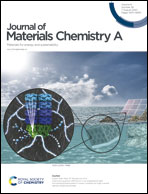A novel molybdenum oxide–Starbon catalyst for wastewater remediation†
Abstract
The exploration of novel media for environmental remediation, in particular wastewater treatment, is a global imperative. Herein, the in situ green synthesis, characterisation and application of a novel Starbon™ composite comprising molybdenum oxide nanoparticles are reported. Starbons™ are carbonaceous mesoporous materials derived from starch with applications ranging from chromatography to gas capture. The molybdenum (Mo) loading, evidenced by inductively coupled plasma-mass spectrometry (ICP-MS), was 179.337 mg g−1, and the molybdenum oxide nanoparticles were observed via transmission electron microscopy (TEM) and energy-dispersive X-ray spectroscopy (EDX). The Mo-containing composite was an efficient catalyst for the reduction of 4-nitrophenol (4-NP) to 4-aminophenol (4-AP) in the presence of sodium borohydride, NaBH4 (k = 11.2 × 10−2 min−1). The Mo-composite showed superior 2,2-diphenyl-1-picrylhydrazyl (DPPH) radical quenching activity with a low inhibitory concentration [IC50 = 1.006 mg ml−1] and ferric reducing power compared with other green synthesised composites and nanoparticles. The novel Mo-containing Starbon™ composite has real time applications in water treatment such as in catalysis, adsorption and filtration.



 Please wait while we load your content...
Please wait while we load your content...